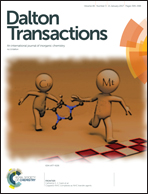Dependence of magnetic coupling on ligands at the axial positions of NiII in phenoxido bridged dimers: experimental observations and DFT studies†
Abstract
A nickel(II) complex [Ni2LR2(CH3CN)4](ClO4)2·2CH3CN (1) has been synthesized by using a tridentate reduced Schiff base ligand, HLR, 2-[(3-methylamino-propylamino)-methyl]-4-nitrophenol and Ni(ClO4)2·6H2O. Stoichiometrically controlled addition of NH4SCN to the acetonitrile–water solution of 1 produced two other complexes, [Ni2LR2(μ1,1-NCS)(CH3CN)2](ClO4)·CH3CN (2) and [Ni2LR2(NCS)2 (CH3CN)2] (3) by replacing one and two coordinated CH3CN by NCS−, respectively. The dinuclear NiII complexes 1 and 3 are structurally very similar containing a diphenoxido bridge between the NiII ions. Complex 2 also consists of a dinuclear entity, but a μ1,1-isothiocyanato bridge is present in addition to the diphenoxido bridge. The magnetic measurements indicate that antiferromagnetic interactions (J = −33.85 cm−1) for 1, (J = −23.43 cm−1) and 3 and ferromagnetic interaction (J = 5.01 cm−1) for 2 are mediated between the intra-dimer NiII ions. The nature of coupling (ferromagnetic for 2 and antiferromagnetic for 1 and 3) is understandable from the phenoxido bridging angles (91.27° (av. angle) for 2, 102.41° for 1 and 102.42° for 3) but it cannot explain the considerable difference of J values between 1 and 3. Other important factors such as Ni⋯O bond distances, the out-of-plane shift of phenyl rings and the hinge distortions are also of no use for a possible explanation. With the help of computational evidence, we have identified for the first time that magnetic coupling could be dramatically modified by the non-bridging axially coordinated ligands: antiferromagnetic coupling becomes considerably stronger for a neutral ligand in comparison to the negatively charged ligand. Moreover, for a negatively charged axially coordinated ligand, antiferromagnetic coupling decreases with increase in crystal field strength.


 Please wait while we load your content...
Please wait while we load your content...